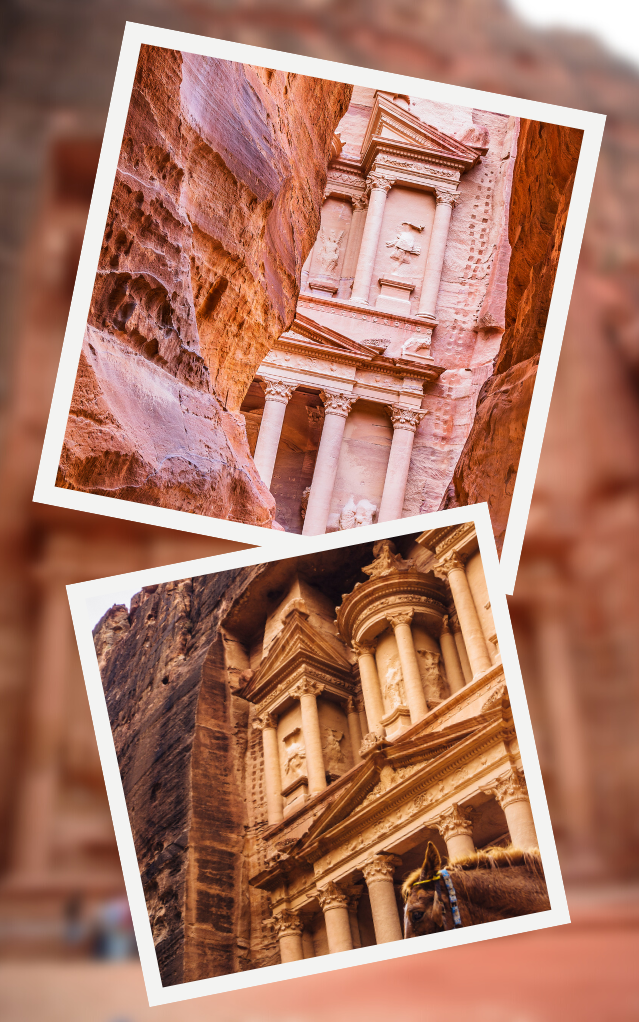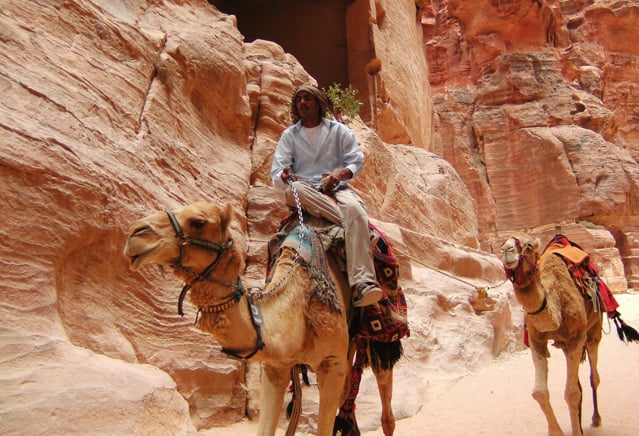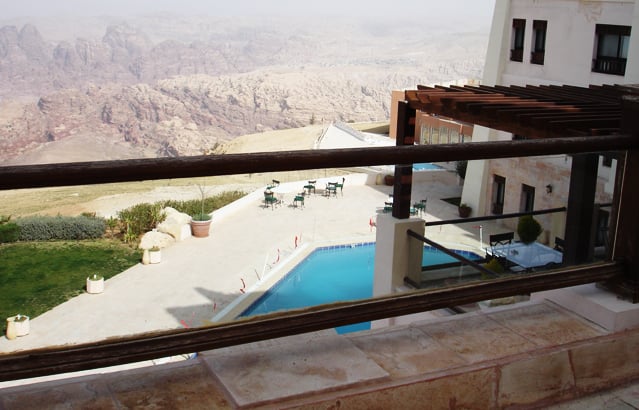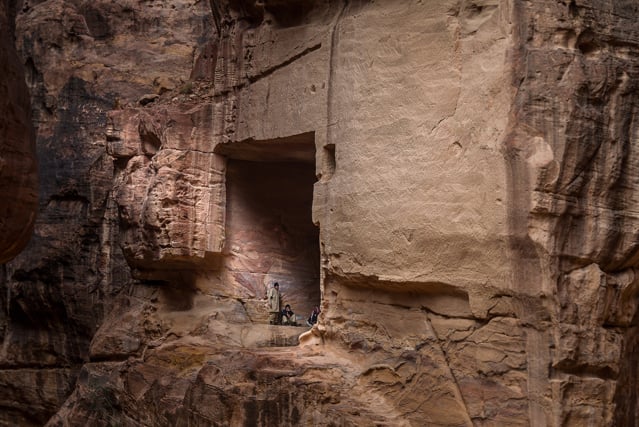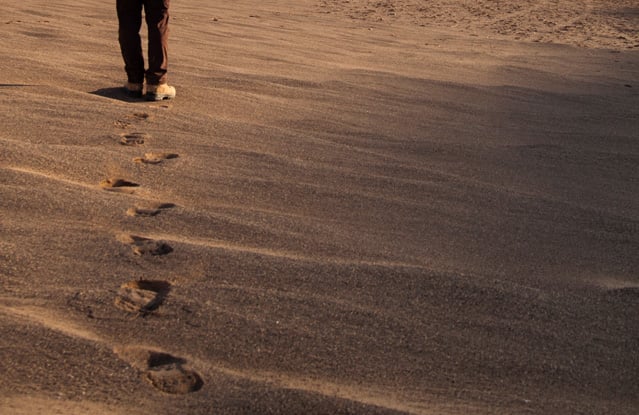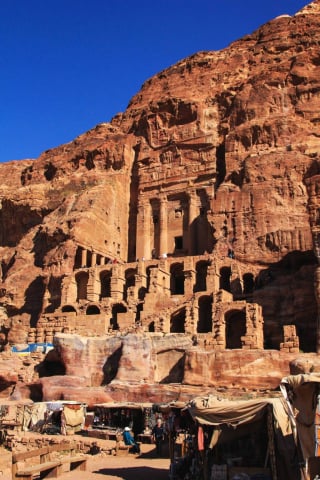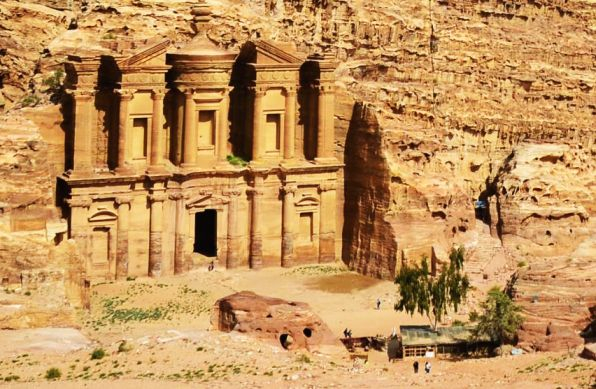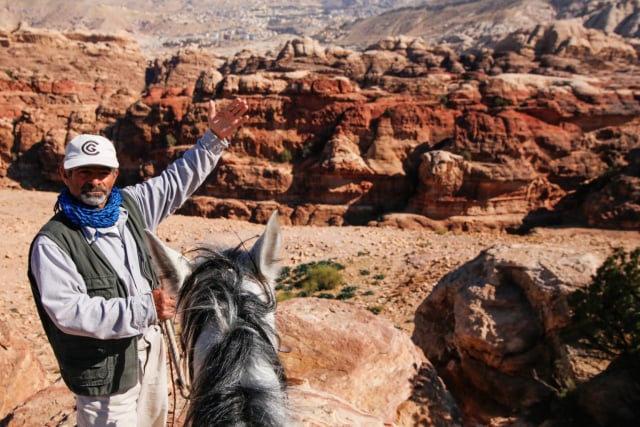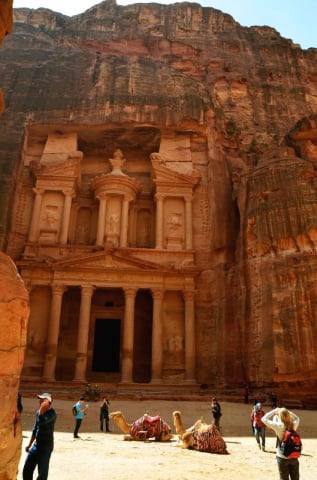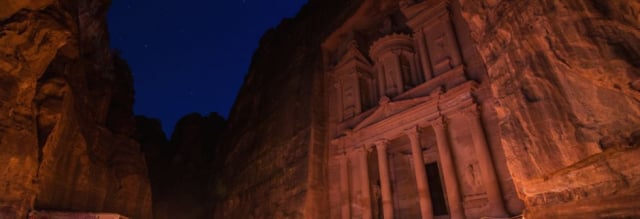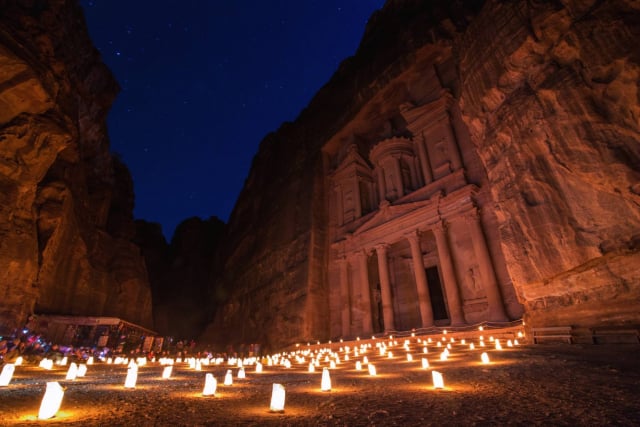When Is the Best Time
No trip to Jordan is complete without a stop at Petra, the stunning and mysterious rose-tinted lost city that stands as the country’s most famous sight.
We have visited Petra in Jordan numerous times during different seasons. That’s why we can answer all the questions you might have about the best time to visit, how long to stay (see the 11 must-know tips at the end), and everything else you need to know.
Our Recommended Tours for You
If you prefer a hassle-free experience with excellent guides, take a look at the tours above, especially if you like to visit Petra (and Wadi Rum) from Amman, Jerusalem, or Tel Aviv. We selected the best tour from each city to Petra (and Wadi Rum Desert). Everything is taken care of (transportation, super friendly guides, accommodation)! You are free to choose any other tour, of course.
Best Time to Visit Petra
The best time to visit Petra in Jordan is in the spring and autumn. The spring months (April to May) and the fall months (October to November) offer pleasant temperatures. It’s not as hot as in the summer, and there are fewer crowds.
The weather can definitely influence your experience at the amazing landmark. However, if you are restricted as to when you can visit, don’t panic. Petra is an excellent year-round destination.
Tip: Also, check out our Ultimate Wadi Rum Guide as well or use the helpful Petra Guide Quick Navigation:
- Petra Season Guide
- Petra Weather
- Petra by Night | Is it worth it?
- Hotel Tips
- Petra Tips at a Glance
- The Most Fascinating Sights
- 11 Must-Know Tips
Continue with the season guide below or jump directly to our Petra Top Tips below as well as a complete guide including every sight.
March – April – May (Spring)
Petra (Jordan) in the spring
The springtime is one of the best times to visit Petra, as the temperatures are milder yet still pleasantly warm, and there is not much rain. In March, temperatures are still relatively cool, hovering between about 18°C (64°F) during the day and getting down to about 6°C (49°F) overnight – so be sure to bring some warmer clothes for the evenings and frosty mornings.
You can also expect there to be a little bit of rain lingering in March. However, when we visited in March, it never disrupted our holidays. By April, the amount of rain is much less, and the average temperature climbs to a high of about 24°C (75°F), dropping to about 10°C (50°F) overnight.
Temperatures continue to climb during May, with a warm average daytime temperature of 28°C (82°F) and overnight lows of about 12°C (53°F). As summer draws near, rainfall is even less during May and it is very unusual for your plans to be interrupted by rain. The skies tend to be a beautiful blue, and there are wildflowers dotted around the landscape, which are great for photographs and views.
Is it crowded?
These pleasant temperatures make the spring months some of the best times to visit Petra. However, you will not be alone in thinking so, and April and May, in particular, attract quite large crowds.
When we visited Petra during the spring, we experienced that these months are indeed one of the busiest times.
If you are planning to visit Petra in spring, be prepared to book tours, transport, and accommodation well ahead of time to avoid any disappointments. You can also expect prices to be fairly high due to the peak demand.
What to wear?
Although the temperatures are quite moderate, it is still advisable to pack clothing for extremes, including long, billowy clothing to protect from the sun, as well as some warmer jackets for the cooler nights.
The milder temperatures of spring also mean that it is fine to visit the site at any time during the day, although if visiting early in the morning it is still worth bringing a warm extra layer or two, especially in March.
June – July – August (Summer)
Petra (Jordan) in the summer
Jordan’s summer months are notoriously hot, meaning the crowds thin as people try to avoid the 40°C plus (100°F+) temperatures. Throughout the three months, there is less variation and June, July and August experience very similar temperatures and almost no rainfall.
In these months, average daytime temperatures hover around 33°C (91°F) and overnight the mercury usually only dips to around 18°C (64°F). It is not unusual for temperatures to soar above these averages, however, with temperatures around Petra sometimes reaching 42°C (107°F) or more. It is usual for the site to be bathed in sun more than 14 hours per day in summer.
How to protect yourself from the heat?
This temperature can be biting, and it is advisable to take care of when visiting Petra in the summer. It is important to wear light, loose-fitting clothing that provides a protective layer from the fierce sun, and bring lots of water.
Petra is a large site, and in such warm temperatures, you can expect to drink a lot more water than you usually would back home. From our experience, it is also strongly advised to try to get to Petra as early as possible when the temperatures are lower. We started our trips as early as possible in the summertime.
Is it quiet tourist-wise?
Generally, the summer months at Petra are far less crowded, so as long as you are prepared for the heat, it can be a great time to visit and have more room to explore. However, if you are visiting with older people or children, or are particularly susceptible to heat, you may want to skip this time.
September – October – November (Autumn/Fall)
Petra (Jordan) in Autumn
September brings much-needed relief from the scorching temperatures, with the mercury starting to drop and average highs of approximately 31°C (88°F) and overnight lows of about 16°C (61°F). Rainfall is very limited, so the chances of your plans being affected by rain are very low.
Overall, September is still quite warm; however, so many visitors stay away until October, when there is a significant drop to approximately 27°C (81°F) during the day, with cooler nights that hover around 11°C (52°F). October is definitely time to put those jackets back in your bag for the chilly evenings, and perhaps a rain jacket as rain is a little more common!
By November, overall temperatures can be quite fresh, with an average maximum of 20°C (68°F) during the day and a cool 7°C overnight (44°F). Warmer layers are definitely required if visiting Petra in November, and it is not unusual for there to be some rain during this time.
Is autumn the best time?
October in particular is a popular month for visitors, so you can again expect full occupancy for hotels and tours, so do book ahead.
Overall, autumn or fall is a great time to visit Petra as the temperatures are typically mild. We noticed during our fall trips that these mild temperatures mean exploring Petra at any time of the day is pleasant. However, we recommend bringing warm clothing if arriving early in the morning as it can still be frosty.
December – January – February (Winter)
Petra (Jordan) in the winter
Most people do not think of Petra as a winter destination, however there are good reasons to visit Petra in the winter months. In December, temperatures are cool, with an average daytime maximum of around 15°C (59°F) and overnight lows hitting a chilly 5°C (41°F). The rain also starts to pick up, and increases towards the end of the month and into January. January can experience quite extreme lows, with an average daytime maximum of 13°C (55°F) and frosty nights that are just a few degrees above zero.
Both January and February can experience some rainy days, and it can even snow at the lost city of Petra. While not very likely, it’s even possible, that Petra is closed for 1-3 days due to rain or snow. We experienced a brief closure once in January.
By February, temperatures are beginning to thaw out a little with an average high of 15°C (59°F), although the nights are still frosty with an average low of 4°C (39°F).
In the winter months, there is still an average of about 7 hours of sunshine per day, although Petra is very occasionally closed due to rain. Therefore, it is advisable to leave several days in your itinerary to visit, just in case weather conditions are prohibitive.
Should I really visit in winter?
Although winter is not the most popular time to visit, there are many reasons why visiting Petra in winter can be a great decision. The site certainly has a unique beauty when it snows, and as long as you dress appropriately for the chilly temperatures, there is no reason the frosty lows should put you off entirely.
Plus, it is a lower season in terms of tourist numbers – one of the benefits of this means that you can visit later in the day (therefore avoiding the cooler mornings) and it is still not too crowded. In addition, winter offers a softer light which is better for picking up the intricate detail of the rock that Petra is carved from.
Petra Weather
Weather in Petra is influenced by its location in the desert, meaning that temperatures can experience quite extreme swings from chilly winters to searing heat in the summer. Even in the warm summer months, overnight temperatures can still be quite cool and mornings can be chilly.
Other features of the desert landscape mean that rain is relatively rare (even in the winter) although not non-existent, and there can be sandstorms, especially in autumn and spring. It also has a high UV index so precautions should be taken to protect from sunburn, even if it doesn’t feel overly hot. Overall, the weather in Petra is similar to nearby Amman, and is considered a desert or steppe climate.
Petra by Night – Is It Worth It?
For a different perspective on Petra, you may like to visit Petra at Night. What is it? Petra Night runs every Monday, Wednesday and Thursday at 8:30 PM. Over 1500 candles are lit. It starts at Petra Visitor Centre. The view can be stunning and romantic, however the decision on whether to visit Petra at night is largely personal.
During the peak months such as April and October, it can be very crowded which makes visibility difficult. Although many photographers dream of snapping the beautiful, atmospheric shots of the Treasury illuminated by candlelight, it can be very difficult to actually get this photo due to the crowds. It is largely a matter of luck whether you will be near the front, or toward the back, although arriving early or waiting until the crowds leave after the show can help.
On the other hand, the low season provides better photographic opportunities but in winter it can be bitingly cold and unenjoyable if you are not properly dressed. However, if you are able to layer up, one of the benefits of visiting during the lower season is that you are far more likely to have an unobstructed view of the candles, which leads to much better photographs. By contrast, summer is also less crowded and the overnight temperatures are actually very pleasant.
In the end, it is a personal decision whether Petra at night is worth the relatively steep cost, however if (like most people) it is the photographic opportunities that draw you to it, then visiting Petra at night in low season may be a great option. During the peak season, however, it may be preferable to skip it altogether unless you are not worried about the cost and happy to ‘roll the dice’ with your view.
Avoiding the Crowds and Heat (Time of Day)
Petra is undoubtedly Jordan’s most popular tourist destination and you should be prepared for crowds. Even in the lowest season, it is unlikely to be completely deserted and during spring and autumn you might find yourself jostling for room! Luckily, there are a few ways to avoid the crowds at Petra.
Go early!
The key way to avoid the crowds is to arrive early, as close to the 6am opening as possible. Most of the tour buses do not arrive as the gates open, so the first hour or two of the day is the best time to explore. Helpfully, this is also generally when the temperatures are at their mildest – so all in all, it is definitely advisable to try to arrive as early as possible. The only time that this is not necessarily the case is during winter, when you may prefer to wait until things warm up a little bit more.
Be aware that even in the warmer months, temperatures do vary and early mornings can still be quite chilly. Even if visiting in a summer month such as June, it is worth bringing a jacket just in case.
Go to different spots!
Another way to avoid the crowds is to try to take in unique viewpoints of Petra. Of course, standing in front of the Treasury is always likely to be crowded, however the site is absolutely huge, and there are many hidden gems where you can get an unobstructed view. For example, you can climb up and look down at the Treasury by following the Al-Khubtha trail. Another beautiful view is from beyond the High Sacrifice. If you go with a guide, they will likely be able to show you some out-of-the-way places where you can get goosebump-inducing views.
Photographing Petra (Time of Day)
Petra Jordan by Sam Amil, CC-BY
The charming and unique lost city of Petra is a photographer’s delight, offering many different views and landmarks to photograph. Plus, as the most well-known landmark in Jordan, photographs of Petra are the quintessential souvenir of your stay in the beautiful country. Here are some tips on how to photograph Petra so as to get brilliant photos that will be a reminder of your memories at the rose city.
Arrive early!
Not only does it help with the crowds and the heat, but it also makes all the difference with your photographs. There are fewer people to crowd your photos and get in your shot, but the light is also better before the sun has risen too high, particularly in the Siq (the leadup to Petra).
By early- to mid-morning and past noon, the crowds make it difficult to get the classic shots of Petra from the Siq. Likewise, the harsh midday sun tends to wash out Petra. If you miss the early start at Petra, your best bet is to return later, as the afternoon near sunset is another great time to photograph Petra.
Make use of different spots and angles!
As already mentioned, try hiking the different trails to get to different vantage points and away from the crowds. Not only does this reduce the change of other visitors ruining your shot, but it gives you a lot of unique and interesting perspectives on Petra. Finally, if you are serious about photography, you may want to purchase a multiple day pass which will give you the chance to thoroughly explore the site and take plenty of photographs from different angles. In addition, you can document the subtle changes that occur daily at this incredible site.
Where to Stay (Hotels We Loved)
View from our hotel by stepnout, CC-BY
As you can see from our tips above, one of the best ways to make the most of your time visiting Petra is to arrive as early as possible. Therefore, you want a hotel which is conveniently located for the lost city. Below are our 2 top picks for where to stay near Petra. If you’d like a different hotel, compare prices here: Petra – Best Prices – Hotels (Tip: bookmark this link). Wondering how long you should spend at Petra? Definitely 2 nights! Petra is huge and you need at least two full days to cover all the fascinating walks/hikes.
Petra Moon Hotel: for convenience of location, you really can’t get much better than the Petra Moon Hotel which is located less than a 5-minute walk from the Petra visitor centre. This is absolutely ideal for visiting Petra early in the morning, as it takes only a few minutes to get to the entrance. The Hotel itself is 4-stars, featuring air-conditioning and free wi-fi. It also has a rooftop terrace where you can enjoy tea as the sun goes down.
B&B Fig Tree Villa: a new but excellent option for where to stay when visiting Petra is the friendly bed and breakfast ‘Fig Tree’ which is less than a ten-minute walk to the entrance. The B&B itself is simple but clean and comfortable, and the owner offers various wellness activities including yoga, massage and a delicious vegetarian breakfast. There is free wi-fi and fans to cool the rooms. We loved it!!
If you are a fan of the Indiana Jones movies, you have to visit PETRA at least once. It was one of the locations for ‘The Last Crusade’. The hidden city where the Bedouins used to live. It’s a fascinating historical and archaeological place in southern Jordan. Famous for its rock-cut architecture and water conduit system.
However, when Petra is mentioned, most people immediately only think of the beautiful rose-tinted Treasury made famous by travel books and movies like the mentioned Indiana Jones one. In reality, Petra is a sprawling city that is quite spread out, with much more to see than just the Treasury. To ensure you have the best time exploring all that the Lost City has to offer, here are our top tips for visiting Petra.
Petra Tips at a Glance
3 Petra Must-Know Tips – Find More Below
In addition to our season and time of day tips above (including Petra by Night and photography tips) we compiled even more extremely useful tips in the big section at the end of this article! However, if you don’t have time here are the best ones at a glance:
- Petra is huge – try to leave at least two days to explore it if you can.
- Get a Jordan Pass. Regardless of how long you stay at Petra and even if you don’t visit other sites. It’s worth it.
- Although there is no official dress code, wear something loose-fitting and modest for your comfort. Don’t forget the hiking shoes!
- Consider hiring a guide who can help explain the significance of everything within the sprawling city.
- Petra is very safe however it is still a good idea to be on alert for scams and pickpockets.
- There are several nice tea shops inside Petra, but you can also bring your own food and drink if you’re on a tight budget or timeframe. Some tea shops even have free wi-fi (as does the Visitor’s Centre).
- Although the horse ride from the Visitor’s Centre to the Siq is ‘free’, you’ll be expected to pay a large tip, so consider skipping over it.
- If you have any mobility issues, the donkey ride to the Monastery may be a good option, however, make sure the donkey is well-treated and agree on a price in advance.
- Sadly, you cannot go inside the Treasury – and will get a serious telling-off if you try!
- Souvenirs from the shops inside Petra can be lovely momentos of your trip, but they are quite expensive, so it’s probably best to leave the bulk of your shopping for later.
Important and Useful Links
- Visit Petra (Official) — The official Petra website
- Jordan Pass (Official) — The official Jordan Pass website, including tips and online order
- Guided Petra Tours & Day Trips — Excellent tours from Amman to Petra and others. They also have some of the best guides!
The Most Fascinating Sights | What to See
There are many great hikes and landmarks to see and explore. Want to know the most fascinating sights? Read on:
The Siq
Your adventure to Petra begins with a hike through the Siq, a winding trail that leads you between two halves of a rocky mountain. It’s an incredibly atmospheric way to start your visit to Petra, as you begin to see glimpses of the Treasury right at the end. Along the way, look out for ancient carvings and water systems that were created by the Nabateans.
The Treasury
At the end of the Siq, you will find the Treasury in all its glory. Even if you have seen it before in books and movies, the imposing stone building is still truly incredible to lay eyes on. Spend as much time as you need soaking it all in.
Street of Facades
After the Treasury, you find yourself in a much more open area – this was once the heart of Petra. One of the first sights you see after the Treasury is the Street of Facades, which has many tombs and houses that were carved out of the sandstone by the Nabateans some 2,000 years ago.
The Royal Tombs
After the Street of Facades, it is fascinating to compare the Royal Tombs, where Nabatean nobility were buried. They are very grand, and you can see many similarities to the style of the Treasury.
The Great Temple
Another unmissable sight in the Lost City is the Great Temple, which is the largest free-standing complex in Petra and almost 2,000 years old.
The Monastery (Ad Deir)
Stunning! This beautiful landmark is the second most unmissable sight in Petra, after the Treasury. In fact, it is larger than the Treasury, and some would say more beautiful. It is quite a strenuous hike to get there – taking about 1.5 hours and about 800 steps – but it is spectacular to see. If you’d prefer not to hike, you can take a donkey ride.
The Place of High Sacrifice
Petra, Jordanie by Guillaume Baviere, CC BY 2.0
The next landmark that is on near everyone’s “must see” list is the Place of High Sacrifice, which was used for religious ceremonies in Petra. It is more easily accessible than the Monastery, and offers beautiful views and the chance to get more perspective on just how huge the lost city is.
Other Hikes
On the way down Umm al-Biyara by Chris – CC BY-SA cropped
Aside from these well-known landmarks, there are many other trails that will take you to some amazing vantage points away from the crowds. Some of the hikes are quite challenging, so make sure you are dressed appropriately and have plenty of water. The names of the trails include the Sabra Trail (6km – moderate), the Al Madras Trail (500m), the Umm Al-Biyara Trail (2km – hard) and the Jabal Haroun Trail (4.5km – hard).
11 Must-Know Tips
For many people, visiting stunning Petra is the trip of a lifetime. To make the most of it, here are our 11 top tips for visiting Petra in detail:
1. Stay as Long as you Can (Preferably 2-3 Days)
As mentioned, Petra is not just the Treasury – it was once an entire bustling city! In order to really appreciate its size and splendours, it is recommended to spend at least two days at Petra. This will allow you not only to take in the major sites such as the Treasury, Monastery and Royal Tombs, but also to explore the less popular trails at your leisure. Plus, the two-day ticket is only fractionally more expensive than the one-day ticket (as well as the Jordan Pass for more days > read below). Of course, if you aren’t able to stay for more than one day, you can still enjoy Petra although you might regret missing out on some things. If you really only have one day: Pre book a tour (like this one: Day Trip to Petra from Amman and buy the Jordan Pass > see below).
2. Get a Jordan Pass
Even if you plan to visit Petra only, get the Jordan Pass! You should also get it regardless of the number of days you plan to spend. Why? You’ll save money because it includes the visa fees of 40 JOD (which always applies if you visit Jordan for 3+ nights):
- Example 1: 50 JOD (one day Petra entrance fee) + 40 JOD (visa fee) = 90 JOD VS 70 JOD (one day Jordan Pass) > 30 JOD saved
- Example 2: 90 JOD (one day Petra entrance fee for non-accommodated(!) visitors) + 40 JOD (visa fee) = 130 JOD VS 70 JOD (one day Jordan Pass) > 60 JOD(!) saved
- Example 3: 60 JOD (three days Petra entrance fee) 40 JOD (visa fee) = 100 JOD VS 80 JOD (three days Jordan Pass) > 20 JOD saved
That means, no matter how long you visit or what you do, the Jordan Pass saves you money. Always! There are three types/’lengths’ of Jordan Passes (Petra for 1 day , 2 days, 3 days). We always suggest to get the 3 day pass to be on the save side in case you consider to stay longer later. You also save the entrance fee for Wadi Rum of course (check our must-read article here) and other sites as well as time because you can skip waiting lines. Where to get it? Buy Jordan Pass (Official Site). Print it or make a screenshot. It’s valid for 12 months. Other useful links: Petra Entrance Fees and Jordan Visa Fees
3. Wear Long, Loose-fitting Clothing
Petra is the tourist hub in Jordan, so it is not unusual to see visitors wearing all kinds of outfits and there is no official dress code. However, it is recommended to wear loose-fitting clothes that cover your shoulders and knees (that’s for all genders). Not only is it respectful of local traditions, but it’s also more sun smart.
4. Wear Hiking Shoes
Many of the trails around Petra are quite challenging, over rocky terrain which is often uneven and sometimes stones come loose. It is definitely recommended to wear appropriate footwear so that you don’t slip. Since exploring Petra on foot means a lot of walking, make sure you wear in your shoes beforehand so blisters don’t ruin your day!
5. Consider a Guide
A guide to Petra is not strictly necessary, however it adds a lot to the overall experience. The Nabateans were very interesting (although there are still many mysteries about them), and a good guide can really bring this history to life. Without a guide, or at least some prior research, you may not appreciate all of the history and engineering behind Petra, as it is not particularly well sign-posted. A guide can be arranged beforehand, from the visitor’s centre, or from within Petra. If you are a history buff, it’s worth researching the guide and booking beforehand to make sure you get a great one. You can always pre-book a tour of course. Check the link in the summary (bullet points) at the top of this article.
6. Take Reasonable Safety Precautions
Petra, like all of Jordan, is a very safe place to visit for everyone from families to female solo travellers. That said, like everywhere in the world, you should still be a little bit alert and careful with your personal belongings. Women should also be aware of the so-called “Romance Scam” where women are invited to the homes of Bedouin families and sometimes made to feel unsafe. Always trust your instincts.
7. It’s Allowed to Bring Food (+ Free Wifi Available)
If you’re on a budget or want to maximise the amount of time spent exploring Petra (rather than eating), you are also allowed to bring in food and water. However, inside Petra you will find many tea shops that sell food and drink, so don’t worry if didn’t bring anything and start to feel a little peckish or thirsty while exploring the Lost City. Some of them have beautiful views, so enjoying a nice lunch or Jordanian coffee can be a highlight. Do you want to check in “at Petra” or perhaps do some last-minute research about the Nabateans? If so, there is also Wifi at some of the tea shops around the site and free Wifi at the Visitor Centre.
8. Skip the “Free” Horse Ride
As you first enter Petra, you will be offered a free horse ride to the Siq which is included in the ticket price. That said, the ride is very short and there is an expectation that you will tip about 5 JOD (7 USD) for the experience. Whether or not the ride is enjoyable depends quite a lot on which guide you get – you may be able to have an interesting discussion about life in Jordan, or you may just get hassled for a large tip most of the way. All in all, it’s probably best just to skip it unless you’re really keen to do it.
9. The Donkey Ride to the Monastery is a Good Option
If you have any kind of mobility issues or would just prefer not to hike up 800 stairs, you might like to take a donkey ride to the Monastery. A few tips about that, though – firstly, please make sure the donkey you ride is well-treated. Many are at Petra, but others are not, and it is important not to support those operators financially. Secondly, agree on the price before you go to avoid any awkward conversations after the ride. If you do think you’ll take the donkey ride, be sure to bring cash!
10. Do Not Try to Go Inside the Treasury
Unfortunately, despite what is shown on Indiana Jones, you cannot enter the Treasury. It’s gated off, and surrounded by some intimidating-looking security guards who will not be impressed if you try to go around the fencing. The good news, however, is that you can go inside many of the other sites, especially away from the main tourist path.
11. Buy Some Souvenirs (but Not Too Many)
Within Petra, and especially in areas such as the walk to the Monastery, you will find lots of people selling souvenirs from Petra fridge magnets to Arabic spices. Like with most popular tourist sites, they are generally not the most affordable or authentic souvenirs, however, it is fun to be able to say you bought something from the Lost City of Petra, and also supports the people who make a living there (some of whom actually lived in Petra until they were moved out and it became a massive tourist site). Therefore, don’t feel bad about buying a couple of things, but it may be best to leave the bulk of your shopping for later.


